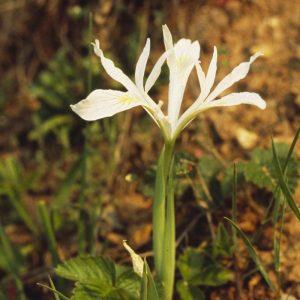
Yellowleaf iris – Iris chrysophylla
Range: Western Cascade Range from mid to southern Oregon; the southern Cascades, Klamath and Siskiyou mountains in northern California; 1000 to above 5000 feet (350-1700 m) elevation.
Original collection: By TJ Howell, Grant’s Pass, Josephine County, Oregon, 1887.
Name: By Thomas Jefferson Howell in 1902, for the plant’s yellowish-green leaves (chryso=golden + phyllo=leaf).

Key identifying features:
- Long, narrow floral tube (2 to 4 inches), only slightly swollen at top.
- Broad, stout spathes, enclosing floral tube.
- Style crests very long and narrow, usually bent upward.
- Standards often spread outward.
- Slender, often fragile-looking, white or pale yellow flowers.
- Narrow, light green leaves, sometimes with reddish tint toward base.
Flower color: White, cream to pale yellow, sometimes a yellow central eyespot; dark golden, reddish-brown or maroon-lavender veins.
Habitat: Road banks, meadows and similar exposed, sunny sites in pine or fir woodlands.
Comments: Long, slender style crests on delicate white to pale yellow or cream color flowers help distinguish I. chrysophylla from other similar wild iris, except its close relative Iris tenuissima.
The relationship and distribution of these two in northern California calls out for further study. Unlike tenuissima, the floral tube in I. chrysophylla remains the same diameter from top to bottom – the top portion is not visibly dilated.
